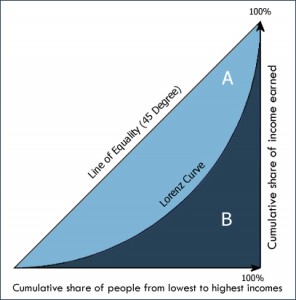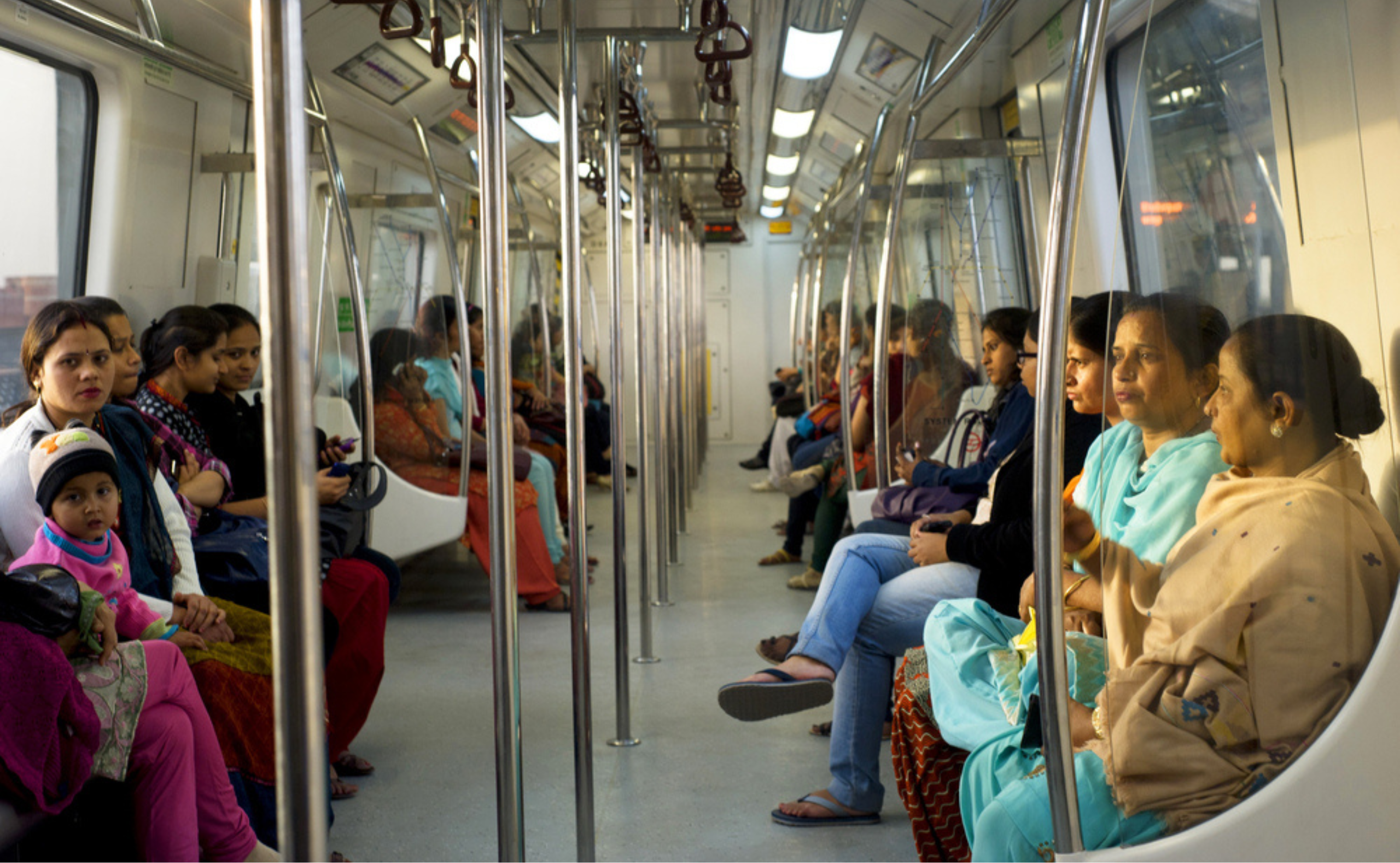 Developing Asia’s impressive growth continues, but faces a new challenge—inequality on the rise.1 Over the last few decades, the region has lifted people out of poverty at an unprecedented rate. But more recent experience contrasts with the “growth with equity” story that characterized the transformation of the newly industrialized economies in the 1960s and 1970s. In the 12 economies that account for more than four-fifths of the region’s population, income disparities expanded during the last two decades—despite the region’s world-beating performance in raising average incomes and reducing poverty. Inequality widened in 12 of the 28 economies with comparable data, including the three most populous countries and drivers of the region’s rapid growth—the People’s Republic of China (PRC), India, and Indonesia. From the early 1990s to the late 2000s, the Gini coefficient worsened from 32 to 43 in the PRC, from 33 to 37 in India, and from 29 to 39 in Indonesia. Treating developing Asia as a single unit, its Gini coefficient rose from 39 to 46 in that period.2 Although Asia’s inequality levels are generally below those in other developing regions—the range of the Gini coefficients in developing Asia is 28−51, compared with 30−66 for Sub-Saharan Africa and 45−60 for Latin America and Caribbean—inequality declined elsewhere, with the exception of the members of the Organization for Economic Co-operation and Development (OECD). The majority of OECD countries—with the Gini in the range of 25−40—also experienced rising inequality in the last two decades.3 Inequality of opportunity is also prevalent, and is a crucial factor in widening income inequality in developing Asia. Unequal access to public services, especially education and health, is central to inequality of opportunity. Household surveys show that school-age children from households in the poorest income quintile were three to five times as likely to be out of primary and secondary school as their peers in the richest quintile in some countries. Infant mortality rates among the poorest households in some countries were double or triple the rates among the richest households. High gender disparities in tertiary education remain in South Asia and the Pacific. The two forms of inequality—of opportunity and income—can lead to a vicious circle as unequal opportunities create income disparities, which in turn lead to differences in opportunities for individuals and households. Why inequality matters Rising inequality can damp the poverty reduction impact of economic growth, and can weaken the basis of growth. A recent Asian Development Bank (ADB) report estimated that, if inequality had remained stable in the Asian economies where it increased, the same growth in 1990–2010 would have taken about 240 million more people out of poverty—equivalent to 6.5% of developing Asia’s population in 2010 (ADB 2012). High and rising inequality can curb long-term growth by leading to a waste of human capital, reducing social cohesion, hollowing out the middle class, undermining the quality of governance, and increasing pressure for inefficient populist policies. Asian policymakers are becoming more concerned about inequality. In a recent informal, web-based survey of Asian policymakers, more than 65% of respondents agreed that income inequality was high or very high.4 Almost all felt that incomes in their countries were becoming more unequal. Moreover, a majority believed that success in reducing poverty was insufficient to justify widening inequality. This concern is increasingly being addressed through medium-term development plans across the region, as they include explicit goals to make growth more inclusive, such as in the PRC, India, Indonesia, Malaysia, and the Philippines. Drivers of inequality Technological progress, globalization, and market-oriented reform have been the key drivers of developing Asia’s rapid growth in the last two decades—but they have also had huge distributional consequences. These forces have opened enormous new opportunities for economies to prosper, but have not benefited all people equally. Together, these forces can explain a large part of the movements in income distribution and inequality in many countries in Asia. These forces affect income distribution through three channels: capital, skill, and spatial bias. The bias toward physical capital reduces labor’s share of national income while increasing the income share of the owners of capital. Similarly, the heightened demand for better skilled workers raises the premium on their earnings. And spatial disparities are becoming more acute: locations with superior infrastructure, market access, and scale economies—such as urban centers and coastal areas—are better able to benefit from changing circumstances. The share of inequality accounted for by differences in education attainment increased in all Asian countries with available data between the 1990s and 2000s, with the increase most significant in the PRC, from 8.1% in 1995 to 26.5% in 2007, followed by India, from 20% in 1993 to 30% in 2010. In the late 2000s, as high as 25−35% of the total inequality can be explained by inter-person differences in human capital and skill endowments in most Asian countries with available data. Between the mid-1990s and the mid-2000s, labor income as a share of manufacturing output in the formal sector fell from 48% to 42% in the PRC and from 37% to 22% in India. The employment intensity of growth in Asia has also declined in the last two decades. Since capital is less equally distributed, this has contributed to rising inequality.5 Inequalities between rural and urban areas and across provinces and states have increased significantly in many Asian countries during the last 2 decades. In the late 2000s, about 25%−50% of total inequality can be explained by spatial inequality—between urban and rural and inter-province and state inequalities combined—in some countries, including the PRC, India, and Indonesia. Policy options for confronting rising inequality Because the forces behind rising inequality are also the engines of productivity and income growth, policymakers should not hinder their progress. A distinction needs to be made between the income differences that arise as economies and individuals take advantage of the new opportunities of technology, trade, and efficiency-enhancing reforms; and those that are generated by unequal access to market opportunities and public services. This latter source of inequality requires a policy response since it gets magnified by the driving forces of growth, leads to inefficiency, and undermines the sustainability of growth. The ADB publication Asian Development Outlook 2012 highlights four sets of policy responses to rising inequality in Asia. These include: (i) efficient fiscal policies to reduce inequality in human capital with a view to addressing the rising skill premium; (ii) interventions to reduce spatial inequality; (iii) policies to make growth more employment friendly with a view to increasing labor demand and hence labor’s share in national income; and (iv) measures to promote equal opportunity through strengthening governance and institutions: Efficient fiscal policies include: (i) spending more on education and health, especially for poorer households; (ii) developing and spending more on better targeted social protection schemes, including conditional cash transfers that target income to the poor but also incentivize the buildup of human capital; (iii) switching fiscal spending from general price subsidies (such as on fuel) to targeted transfers; and (iv) broadening the tax base and strengthening tax administration for greater and more equitable revenue mobilization. Interventions to address lagging regions include: (i) improving transport and communications networks between developed and poor regions; (ii) creating growth poles in lagging areas; (iii) strengthening fiscal transfers for greater investment in human capital and better access to public services in lagging regions; and (iv) removing barriers to within-country migration. Policies to make growth more employment friendly include: (i) facilitating structural transformation to create a greater number of productive jobs, and maintaining a balanced sectoral composition of growth between manufacturing, services, and agriculture; (ii) supporting development of small and medium-sized enterprises; (iii) removing factor market distortions that favor capital over labor; (iv) establishing or strengthening labor market institutions; and (v) introducing public employment schemes as a temporary bridge to address pockets of unemployment and underemployment. The region has enjoyed a remarkable period of growth and poverty reduction, but the new global realities of technological progress, more globally integrated markets, and greater market orientation are magnifying the effects of inequalities in physical and human capital. Asian policymakers need to redouble their efforts to equalize opportunities in employment, education, and health to make growth more inclusive. Without such policies of job creation and efficient fiscal measures to enhance growth, Asia may be pulled into inefficient populist policies, which would help neither growth nor equity. _____ 1 Based on Asian Development Outlook 2012, which is available at www.adb.org/publications/asian-development-outlook-2012-confronting-rising-inequality-asia. 2 A common measure of inequality, ranging from zero indicating perfect equality and 1 indicating perfect inequality. For convenience, this note cites the Gini multiplied by 100. 3 The Gini coefficients are based on per capita expenditure for developing Asia and Sub-Saharan Africa and per capita disposable income for Latin America and Caribbean and OECD countries. Income-based Gini coefficients are normally higher than expenditure-based Gini coefficients, and the difference is in the range of 5−10. 4 The survey was carried out by ADB in January–February 2012. From key government agencies in 25 of ADB’s developing member countries, 504 respondents registered their opinions. 5 The abundance of labor relative to capital, which depresses wage rates, is also a contributing factor to the declining labor income share in developing Asia. References: Asian Development Bank. 2012. Asian Development Bank Outlook 2012. Manila.
Developing Asia’s impressive growth continues, but faces a new challenge—inequality on the rise.1 Over the last few decades, the region has lifted people out of poverty at an unprecedented rate. But more recent experience contrasts with the “growth with equity” story that characterized the transformation of the newly industrialized economies in the 1960s and 1970s. In the 12 economies that account for more than four-fifths of the region’s population, income disparities expanded during the last two decades—despite the region’s world-beating performance in raising average incomes and reducing poverty. Inequality widened in 12 of the 28 economies with comparable data, including the three most populous countries and drivers of the region’s rapid growth—the People’s Republic of China (PRC), India, and Indonesia. From the early 1990s to the late 2000s, the Gini coefficient worsened from 32 to 43 in the PRC, from 33 to 37 in India, and from 29 to 39 in Indonesia. Treating developing Asia as a single unit, its Gini coefficient rose from 39 to 46 in that period.2 Although Asia’s inequality levels are generally below those in other developing regions—the range of the Gini coefficients in developing Asia is 28−51, compared with 30−66 for Sub-Saharan Africa and 45−60 for Latin America and Caribbean—inequality declined elsewhere, with the exception of the members of the Organization for Economic Co-operation and Development (OECD). The majority of OECD countries—with the Gini in the range of 25−40—also experienced rising inequality in the last two decades.3 Inequality of opportunity is also prevalent, and is a crucial factor in widening income inequality in developing Asia. Unequal access to public services, especially education and health, is central to inequality of opportunity. Household surveys show that school-age children from households in the poorest income quintile were three to five times as likely to be out of primary and secondary school as their peers in the richest quintile in some countries. Infant mortality rates among the poorest households in some countries were double or triple the rates among the richest households. High gender disparities in tertiary education remain in South Asia and the Pacific. The two forms of inequality—of opportunity and income—can lead to a vicious circle as unequal opportunities create income disparities, which in turn lead to differences in opportunities for individuals and households. Why inequality matters Rising inequality can damp the poverty reduction impact of economic growth, and can weaken the basis of growth. A recent Asian Development Bank (ADB) report estimated that, if inequality had remained stable in the Asian economies where it increased, the same growth in 1990–2010 would have taken about 240 million more people out of poverty—equivalent to 6.5% of developing Asia’s population in 2010 (ADB 2012). High and rising inequality can curb long-term growth by leading to a waste of human capital, reducing social cohesion, hollowing out the middle class, undermining the quality of governance, and increasing pressure for inefficient populist policies. Asian policymakers are becoming more concerned about inequality. In a recent informal, web-based survey of Asian policymakers, more than 65% of respondents agreed that income inequality was high or very high.4 Almost all felt that incomes in their countries were becoming more unequal. Moreover, a majority believed that success in reducing poverty was insufficient to justify widening inequality. This concern is increasingly being addressed through medium-term development plans across the region, as they include explicit goals to make growth more inclusive, such as in the PRC, India, Indonesia, Malaysia, and the Philippines. Drivers of inequality Technological progress, globalization, and market-oriented reform have been the key drivers of developing Asia’s rapid growth in the last two decades—but they have also had huge distributional consequences. These forces have opened enormous new opportunities for economies to prosper, but have not benefited all people equally. Together, these forces can explain a large part of the movements in income distribution and inequality in many countries in Asia. These forces affect income distribution through three channels: capital, skill, and spatial bias. The bias toward physical capital reduces labor’s share of national income while increasing the income share of the owners of capital. Similarly, the heightened demand for better skilled workers raises the premium on their earnings. And spatial disparities are becoming more acute: locations with superior infrastructure, market access, and scale economies—such as urban centers and coastal areas—are better able to benefit from changing circumstances. The share of inequality accounted for by differences in education attainment increased in all Asian countries with available data between the 1990s and 2000s, with the increase most significant in the PRC, from 8.1% in 1995 to 26.5% in 2007, followed by India, from 20% in 1993 to 30% in 2010. In the late 2000s, as high as 25−35% of the total inequality can be explained by inter-person differences in human capital and skill endowments in most Asian countries with available data. Between the mid-1990s and the mid-2000s, labor income as a share of manufacturing output in the formal sector fell from 48% to 42% in the PRC and from 37% to 22% in India. The employment intensity of growth in Asia has also declined in the last two decades. Since capital is less equally distributed, this has contributed to rising inequality.5 Inequalities between rural and urban areas and across provinces and states have increased significantly in many Asian countries during the last 2 decades. In the late 2000s, about 25%−50% of total inequality can be explained by spatial inequality—between urban and rural and inter-province and state inequalities combined—in some countries, including the PRC, India, and Indonesia. Policy options for confronting rising inequality Because the forces behind rising inequality are also the engines of productivity and income growth, policymakers should not hinder their progress. A distinction needs to be made between the income differences that arise as economies and individuals take advantage of the new opportunities of technology, trade, and efficiency-enhancing reforms; and those that are generated by unequal access to market opportunities and public services. This latter source of inequality requires a policy response since it gets magnified by the driving forces of growth, leads to inefficiency, and undermines the sustainability of growth. The ADB publication Asian Development Outlook 2012 highlights four sets of policy responses to rising inequality in Asia. These include: (i) efficient fiscal policies to reduce inequality in human capital with a view to addressing the rising skill premium; (ii) interventions to reduce spatial inequality; (iii) policies to make growth more employment friendly with a view to increasing labor demand and hence labor’s share in national income; and (iv) measures to promote equal opportunity through strengthening governance and institutions: Efficient fiscal policies include: (i) spending more on education and health, especially for poorer households; (ii) developing and spending more on better targeted social protection schemes, including conditional cash transfers that target income to the poor but also incentivize the buildup of human capital; (iii) switching fiscal spending from general price subsidies (such as on fuel) to targeted transfers; and (iv) broadening the tax base and strengthening tax administration for greater and more equitable revenue mobilization. Interventions to address lagging regions include: (i) improving transport and communications networks between developed and poor regions; (ii) creating growth poles in lagging areas; (iii) strengthening fiscal transfers for greater investment in human capital and better access to public services in lagging regions; and (iv) removing barriers to within-country migration. Policies to make growth more employment friendly include: (i) facilitating structural transformation to create a greater number of productive jobs, and maintaining a balanced sectoral composition of growth between manufacturing, services, and agriculture; (ii) supporting development of small and medium-sized enterprises; (iii) removing factor market distortions that favor capital over labor; (iv) establishing or strengthening labor market institutions; and (v) introducing public employment schemes as a temporary bridge to address pockets of unemployment and underemployment. The region has enjoyed a remarkable period of growth and poverty reduction, but the new global realities of technological progress, more globally integrated markets, and greater market orientation are magnifying the effects of inequalities in physical and human capital. Asian policymakers need to redouble their efforts to equalize opportunities in employment, education, and health to make growth more inclusive. Without such policies of job creation and efficient fiscal measures to enhance growth, Asia may be pulled into inefficient populist policies, which would help neither growth nor equity. _____ 1 Based on Asian Development Outlook 2012, which is available at www.adb.org/publications/asian-development-outlook-2012-confronting-rising-inequality-asia. 2 A common measure of inequality, ranging from zero indicating perfect equality and 1 indicating perfect inequality. For convenience, this note cites the Gini multiplied by 100. 3 The Gini coefficients are based on per capita expenditure for developing Asia and Sub-Saharan Africa and per capita disposable income for Latin America and Caribbean and OECD countries. Income-based Gini coefficients are normally higher than expenditure-based Gini coefficients, and the difference is in the range of 5−10. 4 The survey was carried out by ADB in January–February 2012. From key government agencies in 25 of ADB’s developing member countries, 504 respondents registered their opinions. 5 The abundance of labor relative to capital, which depresses wage rates, is also a contributing factor to the declining labor income share in developing Asia. References: Asian Development Bank. 2012. Asian Development Bank Outlook 2012. Manila.
- Social development and protection
Confronting rising inequality in Asia
About the Author

Juzhong Zhuang
Juzhong Zhuang is deputy chief economist of ADB’s Economics and Research Department.
Related Posts

- Information and Communications Technology, Social development and protection, Strengthening Governance and Institutional Capacity

- Gender, Social development and protection, Transport
Subscribe to our Newsletter
Stay updated with ADBI news, publications, events and opportunities.

